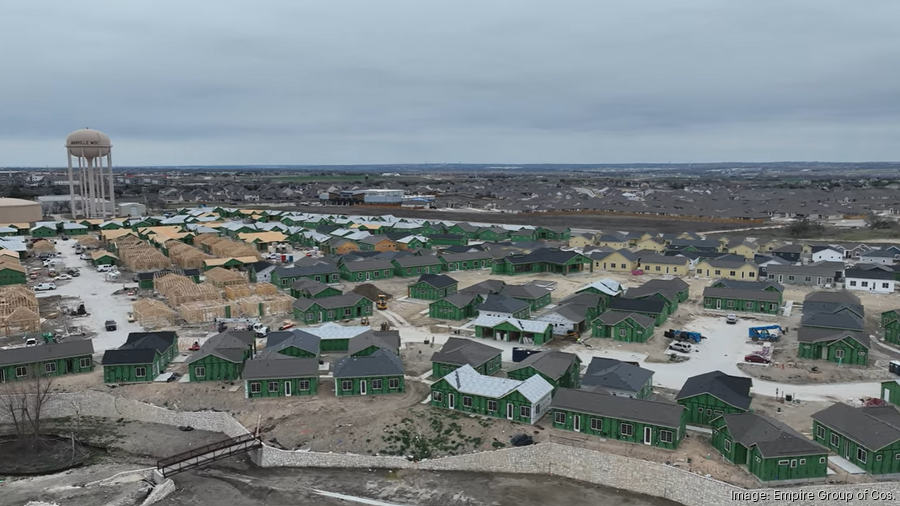
Austin Business Journal writes, "Build-to-rent neighborhoods cropping up all around Austin could be one solution to the metro’s crisis-level shortage of affordable housing, some experts contend.
Developers like Arizona-based NexMetro Communities and Empire Group of Cos. have build-to-rent projects set to open here soon. The neighborhoods — which consist entirely of single-family homes built for rental use — are largely in the suburbs, such as Empire Group's projects in Hutto and NexMetro's projects in Liberty Hill and Georgetown.
Empire Group partner Randy Grudzinski said the model is intended to address affordability by offering something between renting an apartment and owning a home.
Build-to-rent homes "allow people to have an interim step before they can actually buy a home,” Grudzinski said. “It gives more time to save money, more time to pay down debt, maybe more time for mortgage rates to go down. But it offers them a solution to get out of an apartment building.”
While home prices in Austin have fallen from pandemic-era highs, they're still out of reach for many buyers. The median sales price of a home in January in the metro was $409,765, according to the Austin Board of Realtors and Unlock MLS, while the average 30-year fixed-rate mortgage as of March 5 was 6.63%, according to Freddie Mac.
The median family income for a family of four in the metro was $126,000 as of June 2024, according to the city of Austin.
As a housing option, build-to-rent homes can provide the flexibility and benefits of multifamily housing in a single-family format. For instance, NexMetro — which has three such neighborhoods set to open in the metro this year — offers property management services that include free maintenance and lawn mowing, said Jason Flory, NexMetro managing director of Austin and Atlanta.
While landlords of traditionally built single-family rentals also can offer those services, the build-to-rent model has major differences said Daniel Oney, director of research at the Texas A&M University's Texas Real Estate Research Center.
That's because developers of build-to-rent neighborhoods can save money by building multiple homes from scratch in a single location, such as by purchasing construction materials in bulk, Oney said. General operations of such neighborhoods “should be cheaper as well,” he said, because management and maintenance crews can concentrate on specific areas.
Still, Oney said current economic conditions could slow development of new build-to-rent housing.
“The hope was that build-to-rent would be the answer to expensive housing,” Oney said. “One of the problems is the interest in that grew so dramatically when interest rates were really low and it was cheaper for developers to borrow money and build these. Now, it’s more expensive to build anything. We’re seeing a slowdown in apartments and industrial, so it may not make as much sense for builders.”
Empire Group's Grudzinski concurred that any kind of development — from single-family to office to industrial — is less expensive when interest rates are low. That's why the low-rate environment immediately following the pandemic spurred big upticks in apartments and build-to-rent neighborhoods.
Still, Grudzinski said the population of the Austin area is growing fast and much of the excess apartment and build-to-rent inventory is getting absorbed, which he expects will result in a swing from having a surplus to a deficit at some point in 2026.
"High mortgage rates and low supply of for-sale homes results in high cost of ownership," he said in an emailed statement. "This forces people to have to rent, hence high absorption. With high absorption, any oversupply is eaten up. And with permits down dramatically, no new inventory on the horizon is going to result in rent inflation."
But development of build-to-rent neighborhoods comes with some challenges. Chief among them is educating the public, said NexMetro's Flory. Because the housing model is relatively new, it can be difficult to make inroads with existing single-family homeowners and homeowner associations in a community.
“The first thing you do is call the neighbors, you get the homeowners association on board,” Grudzinski said. “You have a meeting, you sit down, you explain what your product is and why it’s not going to feel like a traditional multifamily, why it’s not going to live that way.”
The other challenge, Oney said, is that build-to-rent is still a niche product that needs to attract more institutional investors to grow. He compared the model to another niche product — student housing.
“The reason (student housing) models work, and what will have to happen for build-to-rent to really take off, is you have to get the institutional money involved. I think it will continue to grow, but I think it will still be considered a niche product within real estate.”"
Source: Austin Business Journal
Written by: Cody Baird
Published: March 12, 2025
Posted by Grossman & Jones Group on
Leave A Comment